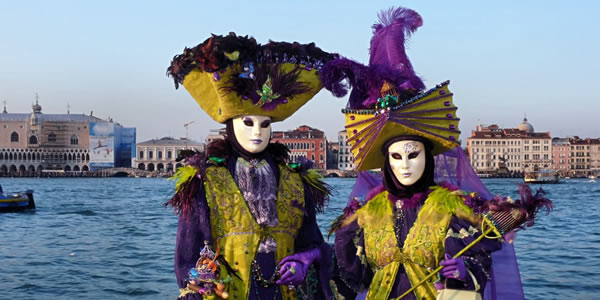- Places
- Plans
- Itineraries
- Experiences


A generally more stately and refined affair than its more rowdy cousin festivals in New Orleans and Rio, Venice's Carnival takes up the days immediately preceding Lent, the 40-day period of penitence and abstinence prior to Easter, which itself migrates about the calendar; Carnevale usually falls in February or early March.
(By the way, the name "Carnevale" is derived from the Latin carnem levare—"to take meat away"—since many people gave up meat for the duration of Lent.)
These days Carnevale lasts no more than five to 12 days, culminating in the Friday-to-Tuesday long weekend preceding Ash Wednesday (in other words it ends on Fat Tuesday, which in Italian is Martedí Grasso, though you might know it by its French name Mardi Gras).
Back in Carnevale's 18th-century heyday, however, revelers came from all over Europe to take part in festivities that began months ahead, gaining crescendo until their raucous culmination at midnight on Shrove Tuesday.
As the Venetian economy declined and its colonies and trading posts fell to other powers, the Republic in its swan song turned to fantasy and escapism. The faster its decline was, the longer and more unlicensed became its anything-goes merrymaking.
Carnival masks became ubiquitous, affording anonymity and pardoning a thousand sins. They permitted the fishmonger to attend the ball and dance with the baroness, and allowed for the properly and soberly married to carry on as if they were, ahem, not.
The doges condemned it and the popes denounced it, but nothing could dampen Carnevale spirit...until Napoléon arrived in 1797.
After nearly two centuries of suppression and fond memories, Carnival was was resuscitated in 1980 by local tourism powers as a way to fill the empty winter months.
Carnevale is calmer now than it was ain the bad old days, though just barely. The born-again festival got off to a shaky start, met at first with indifference and skepticism, but in the years since, it has grown in size, scope, and acceptance amongst Venetians.
The new Carnevale is at its dazzling best now with nearly three decades under its belt, a harlequin patchwork of musical and cultural events, many of them free.
Today's Carnevale events, masked balls, and costumes usually evoke that 18th-century era of Casanova and masked, costumed frippery.
Musical events are staged in any of the city's dozens of sqaures and campi—from reggae and zydeco to jazz to baroque and chamber music—and special art exhibits are mounted at museums and galleries.
In recent years there's been an noticeable uptick in international corporate sponsorship, which as has met with a mixed reception—though someone has to pick up the tab for the party.
Check with the tourist office (www.turismovenezia.it) and Carnival office (www.carnevale.venezia.it) for a list of events.
If you want to get into most of the masked balls, you either have to know someone or book waaaay ahead. Like 5–7 years ahead:
Carnevale ★★
tel. +39-041-241-0570
www.carnevale.venezia.it
Carnevale isn’t for those who dislike crowds—the crowds are what it's all about.
Truly enjoying Carnevale means giving in to the spontaneity of magic and surprise around every corner, the mystery behind every mask.
Period masks and costumes are everywhere. Groups travel in coordinated getups ranging from a contemporary passel of clowns to the court of the Sun King in all its wigged-out drag-queen best.
The places to be seen in costume (only appropriate costumes need apply) are the historic cafes lining Piazza San Marco, the Florian being the unquestioned Command Post.
Don't expect to be seated in full view at a window seat unless your costume looks like it came straight off the stage of the local opera house.
Share this page
Search ReidsItaly.com